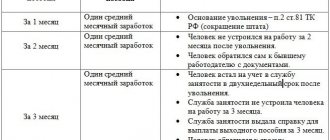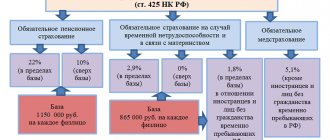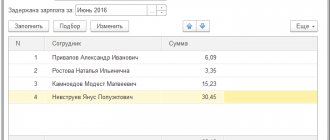An employee may work for less than a full month, for example, due to another vacation or illness, recent execution of an employment contract, or rest at his own expense. The accountant needs to calculate his salary in accordance with the actual time worked and the applied remuneration system. Let's talk about the methodology for calculating wages for a month not fully worked, and give examples of such calculations.
Question: How to calculate a monthly salary if an employee was on vacation for 2 weeks and on a business trip for 5 days? How to calculate salary for an incomplete month? View answer
Payroll calculation if an employee just got a job
When hiring an employee not from the first day of the month, for example, in the middle or at the end, salary calculations are carried out in the same way as when calculating for an incomplete month.
Let's take a closer look at the example
Ivanov I.I. I got a job at Continent LLC not from the beginning of the month, but from August 4, 2021. Ivanov’s salary is set at 50,000 rubles. From August 4 to August 31 there are 20 working days. Let’s calculate Ivanov’s salary for the first working month:
50,000 / 23 x 20 = 43,478.26 rubles.
We take 23 to be the number of working days in August according to the production calendar.
Important! An employee's salary is one of the main conditions for cooperation between the employee and the employer. It must be specified in the employment contract with the employee.
How to determine the number of days
The formula for calculating wages for a part-time working month specifies that it is necessary to determine how many days a person worked. All worked and unworked days for each employee are reflected in the time sheet. For this purpose, organizations are offered to use document forms developed and approved by the State Statistics Committee in Resolution No. 1 dated January 5, 2004, according to forms T-12 and T-13.
Read more: Sample of filling out a time sheet
If a unified form is used to record working time, then information about the time of going to work and time of absence is reflected in the corresponding alphabetic or numerical codes. They are given in Resolution 1 as an appendix to Form T-12. Thus, going to work is indicated by the letter “I” or the digital code “01” with a parallel reflection of the number of hours worked. When reflecting information about no-show, only the corresponding code is indicated (“B” - temporary disability, “OT” - regular leave), hours are not indicated.
Using data on hours worked and periods of absence, we determine the amount to be paid in person.
Please note that organizations have the right to develop their own form of the document, observing certain rules:
- reflect in it all the necessary mandatory details: name, number, date of the document, company details, signatures of responsible persons (Part 2 of Article 9 of the Federal Law of December 6, 2011 No. 402-FZ “On Accounting”);
- provide the ability to reflect information about the days of work and periods of absence of each employee.
This opportunity appeared for organizations after the accounting law of December 6, 2011 No. 402-FZ came into force (Part 4, Article 9). The Federal Service for Labor and Employment does not object to this (letter dated February 14, 2013 No. PG/1487-6-1).
Read more: Calculator, how to calculate salary based on salary
If there are holidays at the beginning of the month
There are often situations when an employee gets a job on a day other than the first day of the month, but only because the first days were holidays.
For example, an employee gets a job immediately after the New Year or after the May holidays. He, like other employees, will work the same number of days this month; accordingly, he will receive his salary in full, despite the fact that he did not get a job from the beginning of the month.
Let's take a closer look at an example: (click to expand)
Kolosova N.P. are hired at the beginning of the new year. His first working day is January 9, 2021, since 1 to 8 are public holidays. Kolosov’s salary was assigned 35,000 rubles. Kolosov is entitled to his full salary for January. Despite the fact that he was registered at work only on the 9th, he worked all working days of the month, since the 1st to the 8th were weekends.
However, if a situation arises when an employee writes an application for leave of his own free will from January 9, 2021, the calculation will be different. In this case, the employee is not entitled to a salary, since he has not worked a single day. From January 1 to January 8 there were holidays, and from the 9th to the end of the month he was on vacation.
Which remuneration systems have become most widespread in Russia?
Article 143 of the Labor Code of the Russian Federation reveals the concept of a tariff system of remuneration.
It is based on differentiation of payments to employees according to the complexity of the work they perform. It is quite natural that the shop manager at an enterprise receives more than an ordinary worker. But in addition to the complexity of the work, differences in salary can also be based on the qualifications of the employee. Tariff rules are established by local regulations, for example in a collective agreement. And the specific employment contract of each employee specifies the conditions that apply specifically to him.
The tariff system of remuneration has two common forms:
- piecework;
- time-based.
Piece system
When using the piecework form of remuneration, the employee receives a salary for how much he has done in a certain period of time. This form is used when you can see and record the specific result of an employee’s activities for a day, week or month.
Time system
The time-based wage system implies that the employee is paid for the time he devoted to his work. This makes it easier to calculate salaries for employees whose results are of an intangible nature.
Commission system
When using a commission-based pay system, an employee receives a salary that is directly dependent on how much money he makes for the company. Most often, the commission form is used in trading. The employee receives a percentage of the sales he makes, agreed upon upon employment.
If you decide to change the wage system at your enterprise, check out the Ready-made solution from ConsultantPlus. The material will help you formalize all changes correctly and avoid disputes with employees. If you don't have access to K+ yet, use a free trial and get answers to all your questions.
If the employee worked on weekends
Even if an employee did not work fully for the whole month, for example, due to illness, he can work on weekends or holidays. But this does not mean that some days can be replaced by others, that is, if an employee was sick for 3 days and worked on weekends for 3 days in the same month, this will not mean that he worked the entire month. That is, it is impossible to simply pay him the required salary; it is necessary to make a calculation.
Let's take a closer look at an example: (click to expand)
Employee Turkina M.A. in October 2021, I took vacation at my own expense on the 4th, 5th and 6th. At the same time, in October she worked 3 days off – October 14, 21 and 28.
She worked 22 days in October, that is, as much as indicated in the production calendar, but she simply cannot pay the salary. Let’s calculate Turkina’s salary based on the fact that her salary is 30,000 rubles.
Work on weekends in the organization is paid at double the rate.
30,000 / 22 x 19 + 30,000 / 22 x 3 x 2 = 25,909.09 + 8,181.82 = 34,090.91 rubles.
Payroll calculation for part-time work
Hello. Please help me calculate my salary for 2 days. The employee goes on vacation from July 4 to July 31 (I counted vacation pay). Salary 2500 (works at 0.5 rate) part-time. The employee worked for a year, July 2021 - June 2021 - 30,000 (payments taken into account when calculating average earnings) Tell me how to correctly 1). 2500/22 (working days in July) * 2 working days (July 2, 3) = 227.27 2). or 170.06 (30000/12/29.4*2)
Quote (Lena Lakhtina): Hello. Please help me calculate my salary for 2 days.
The employee goes on vacation from July 4 to July 31 (I counted vacation pay). Salary 2500 (works at 0.5 rate) part-time. The employee worked for a year, July 2021 - June 2021 - 30,000 (payments taken into account when calculating average earnings) Tell me how to correctly 1). 2500/22 (working days in July) * 2 working days (July 2, 3) = 227.27 2). or 170.06 (30000/12/29.4*2)
How to calculate vacation pay
When determining the amount of vacation pay and compensation for unused vacation, it is first necessary to calculate the average daily earnings. Its formula depends on whether the billing period has been fully worked out, that is, 12 calendar months preceding the month the vacation starts.
If the billing period has been worked out in full, then the average daily earnings are equal to the salary accrued during the billing period, divided by 12 months and by the average monthly number of calendar days (it is equal to 29.3).
If the billing period has not been fully worked out, then the salary accrued during the billing period must be divided by a certain number. To find it, you need to multiply the number of fully worked months by 29.3 and add the number of calendar days in incompletely worked months.
Having calculated the average daily earnings, we multiply it by the number of calendar days of vacation. The result is the amount of vacation pay (or compensation for unused vacation), which is given to the employee.
Calculate your salary and vacation pay in the web service Calculate for free
Read more about calculating vacation pay in the article “How to calculate vacation pay in 2021.”
How to calculate sick leave benefits
Here you also need to calculate the average daily earnings, but the algorithm for calculating it will be different than in the case of vacation pay.
First you should calculate the so-called average earnings. In general, it is determined for two calendar years preceding the year of onset of the disease. So, if sick leave is issued in 2021, then we calculate the average earnings for 2021 and 2021. Average earnings include all payments to the employee for which insurance premiums were calculated. In particular, vacation pay and quarterly bonuses are included in the average earnings, but sick leave and maternity leave are not included.
Then you need to calculate your average daily earnings. To do this, take the average earnings and divide by 730. Multiply the resulting amount by the percentage corresponding to the insurance period. If the experience is 8 or more years - 100%. If the experience is from 5 to 8 years - by 80%. If the experience is less than 5 years - by 60%. As a result, we will receive the amount of daily temporary disability benefits. It should be multiplied by the number of calendar days of illness. The result of this multiplication will be the final benefit amount.
IMPORTANT
The rule applies from April 2021. If the temporary disability benefit calculated for a full calendar month is less than the minimum wage (RUB 12,130), then sick leave is paid in the amount of the minimum wage for a full calendar month. Then the amount of the daily benefit is the minimum wage divided by the number of calendar days of the month in which the illness occurs. The total benefit is the daily benefit multiplied by the number of calendar days of sickness in each calendar month. If a regional coefficient is introduced, then the minimum wage is determined taking into account this coefficient (for more details, see: “Sick leave in 2021: the temporary procedure for calculating benefits was made permanent”).
Maternity benefits have their own specifics. We calculate average earnings as described above, but average daily earnings differently. The difference is that we divide the average earnings not by 730 days, but by the number of calendar days in the two previous years minus the days when the woman was on sick leave, maternity leave, or child care leave; as well as additional paid days off to care for disabled children and days when a woman was released from work according to the laws of the Russian Federation with full or partial retention of her salary. We always multiply the resulting amount by 100%, regardless of the insurance period.
Calculate your salary and benefits according to current rules Calculate for free
You can read more about the accrual of sick leave in the article “Payment of sick leave in 2021.”
If a person gets sick
Illness, like maternity leave, is not a reason for dismissal or deprivation of a subordinate’s salary. The legislator obliges the employer to preserve for the sick person the place and average earnings for the period during which, according to the certificate of temporary incapacity for work, the citizen was ill.
Sick leave benefits are paid from the following funds:
- enterprises – first 3 days:
- the remaining days of deductions are made by the Social Insurance Fund.
First, the employer makes payments from his budget, and then the Social Insurance Fund returns this amount to him.
When paying sick leave, different indicators are taken into account than for other reasons for absence from work. What matters here is:
- average salary for the last two years;
- total experience - with 5 years of experience, 60% of the minimum wage is given, with 6 - 8 years - 80%, from 8 years - 100%;
- availability of official employment.
If a citizen is employed unofficially, the employer does not contribute funds to the Fund, which means that the citizen is not entitled to a payment from it. Of course, you will also need a sick leave certificate issued by your attending physician.
The legislative framework
To make the calculations correctly, it is necessary to take into account the requirements of regulatory documents :
- Art. 133 of the Labor Code of the Russian Federation - how to correctly deduct the minimum income of an employee;
- Art. 136 of the Labor Code of the Russian Federation - terms and procedure for transferring funds;
- Art. 137 of the Labor Code of the Russian Federation - application of restrictions regarding deductions from wages;
- Art. 139 of the Labor Code of the Russian Federation - rules for subtracting average pay;
- Art. 142 of the Labor Code of the Russian Federation - responsibility of the employer;
- Art. 144 of the Labor Code of the Russian Federation - wage options for budgetary and government institutions;
- Art. 135 of the Labor Code of the Russian Federation - remuneration under special conditions;
- Art. 152, 153, 154 of the Labor Code of the Russian Federation - how to properly pay for work on holidays, nights and overtime;
- Art. 157 of the Labor Code of the Russian Federation - payment for downtime.
In addition, Art. 122 of the Labor Code of the Russian Federation indicates that the amount of earnings will be maintained even if there are holidays during the working period.
The employee goes on vacation in the middle of the month when the salary is paid
When an employee goes on vacation, most accountants pay him not only vacation pay, but also wages. Is this legal? Or is it prohibited to make early wage payments? This article will discuss this issue in detail. 09/07/2016
Is it dangerous to pay wages along with vacation pay? There are no specific violations in the fact that the accountant will pay wages along with vacation pay.
In addition, these actions significantly improve the financial situation of employees. Article No. 136 of the Labor Code of the Russian Federation states the fact that wage payments are acceptable more often than twice a month. Therefore, the accountant has the right to transfer to the employee the salary for those days that were worked before the vacation, along with vacation pay.
Features of calculation for a shift schedule
Payroll calculation according to a shift schedule can be formed as follows:
There is a certain store that is open from 8 to 22 pm. Work schedule - 2 days every other. One shift of a salesperson is 14 hours. The first saleswoman begins her work in the current billing period on the 2nd, and the second - on the 4th. There are only 30 days in a month, so the first one worked 16 days, and the second one 14. However, the first saleswoman missed 4 of her shifts due to illness, and the second one had to replace her during this period of time. The employer has established a fee for one shift in the amount of 1200 rubles.
We first calculate the amount of wages that should have been initially:
- Salary of the first employee: 16*1200 = 19200 rubles.
- Salary of the second employee: 14*1200 = 16800 rubles.
However, the first saleswoman did not work 4 shifts, so we subtract the cost of these shifts from her salary:
19200 – 4*1200 = 14400 rubles will be received by the first employee for less than a month.
Accordingly, the second’s salary will increase proportionally:
16800 + 4*1200 = 21600 rubles.
How often to calculate and pay salaries
In general, wages are calculated at the end of each month.
The salary amount is the amount a person earned in a given month. Salaries must be paid at least once every half month (Article 136 of the Labor Code of the Russian Federation). To meet this requirement, the monthly amount must be divided into two parts. The first part should be given to employees before the end of the month, that is, in advance. The second part is after the end of the month, when the final salary amount will be known.
Calculate your advance and salary taking into account all current indicators Calculate for free
The deadlines for issuing advance payments and salaries are not established in the Labor Code of the Russian Federation. But the rule applies: money must be issued no later than 15 calendar days from the end date of the period for which it was accrued. Each employer has the right to approve its own dates. For example, pay an advance on the 25th of each month, and pay a salary on the 10th of the month following the month worked. The main thing is that these dates are recorded in an internal regulatory document (for example, by order of the director) and are strictly observed. If the day of payment of an advance or salary falls on a weekend or holiday, then the money must be paid the day before.
As for the amount of the advance, it is also not specified in the law, and organizations set it at their own discretion. In practice, there are two ways to calculate the advance. The first is to take the employee’s monthly salary and multiply by 40% (can be 30% or 50%). The second way is to calculate the exact amount of salary for the first half of the month actually worked. This approach is welcomed by officials (letter of Rostrud dated 09/08/06 No. 1557-6), but is not always applied in life (read more about calculating an advance in the article “Salary for the first half of the month: how to calculate the advance and what amounts to withhold from it”).
Regulatory regulation
Any calculations that are carried out within the framework of an employment contract must be carried out in accordance with the requirements of the law. The main regulatory legal act in this area is the Labor Code of the Russian Federation (hereinafter referred to as the Labor Code of the Russian Federation), Chapter VI. The Labor Code norms regulate the following issues:
- Articles 133, 133.1 – establish the rules for determining the minimum wage.
- Art. 135 – the procedure for establishing wages (hereinafter referred to as the salary), determination of remuneration systems, organizational issues.
- According to Art. 136 can determine how, where and when the salary is paid. The documents that should contain such information are also listed here.
- According to Art. 137, 138 deductions are made from the employee’s salary. Legal cases of deductions are listed, as well as the limits of deductions.
- The fundamental norm for carrying out many calculations is Art. 139, since it establishes the rules for calculating average wages.
- Articles 146 - 148 establish the payment procedure for persons employed in jobs hazardous to health or with special working conditions.
- Art. 150 - 151 – settlements with employees who work in several areas.
- Wages for overtime by hour and day are established according to Art. 152 - 154.
- Payment for labor that turned out to be of poor quality due to the fault of the employee is 155 - 156.
- Peculiarities of ZP during idle or new production – 157 – 158.
The legislator also guarantees the preservation of the employee’s earnings on holidays and the employer’s liability for violation of wage legislation (122, 142).
Salary upon dismissal
If a person decides to quit without working for a full month, then the balance due to him is calculated according to the system that is used at the enterprise according to the above formulas.
In order to fully pay a subordinate, the accounting department must check the availability of unused vacations. If any are identified, the employee should be offered to use them or compensate them with vacation pay.
Example: a specialist served in the organization for 20 days with a salary of 35,000 rubles. After 20 days he quit, then the total amount will be calculated in several stages:
- Salary for financial support: 35,000 / 22 * 20 = 31,818 rubles.
- To calculate vacation compensation, you first need to establish the average daily salary: 31,818 /20 = 1,590 rubles.
- The resulting value is multiplied by 2.33 days, since according to the law, working more than 15 days is considered to be fulfilling the full monthly plan. This means that the compensation will be 1590 x 2.33 = 3,704 rubles.
This means that on the day of leaving the person will receive 31,818 + 3704 = 35,522 rubles.











